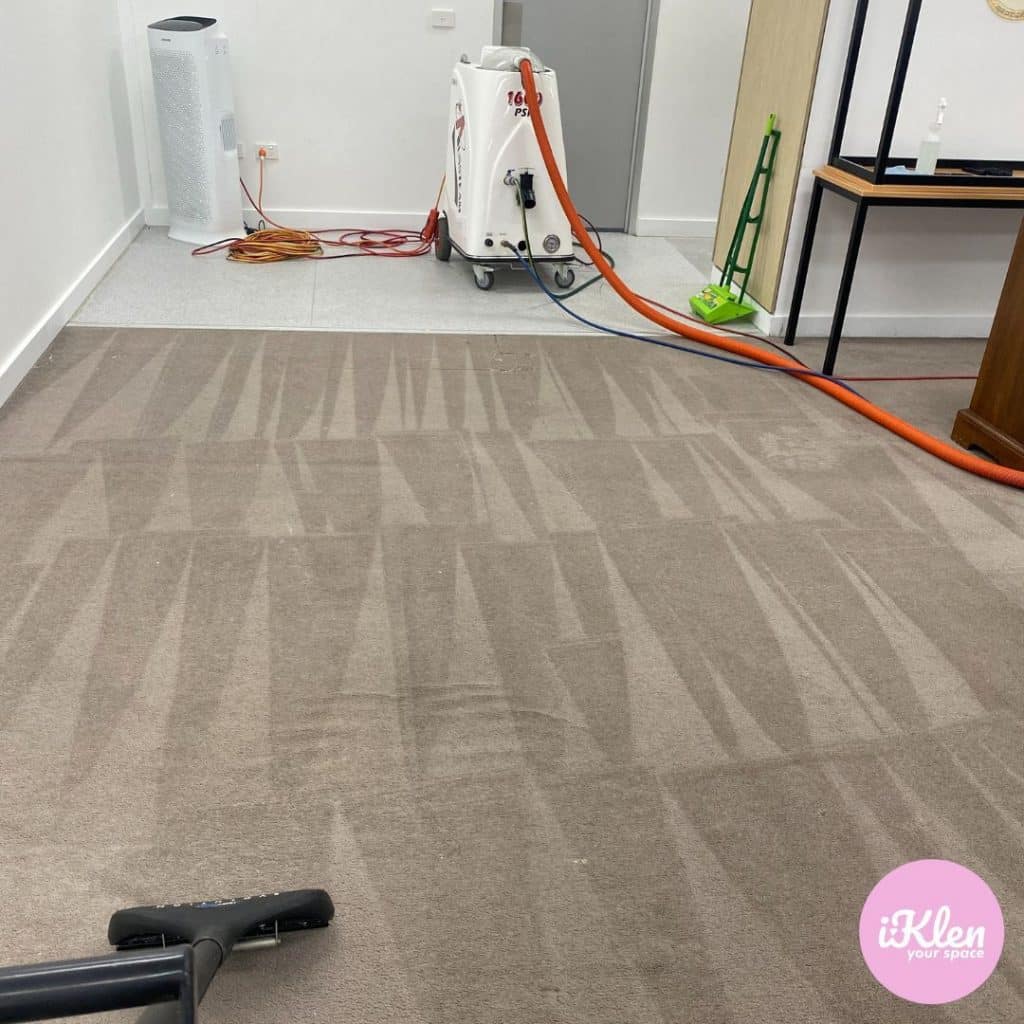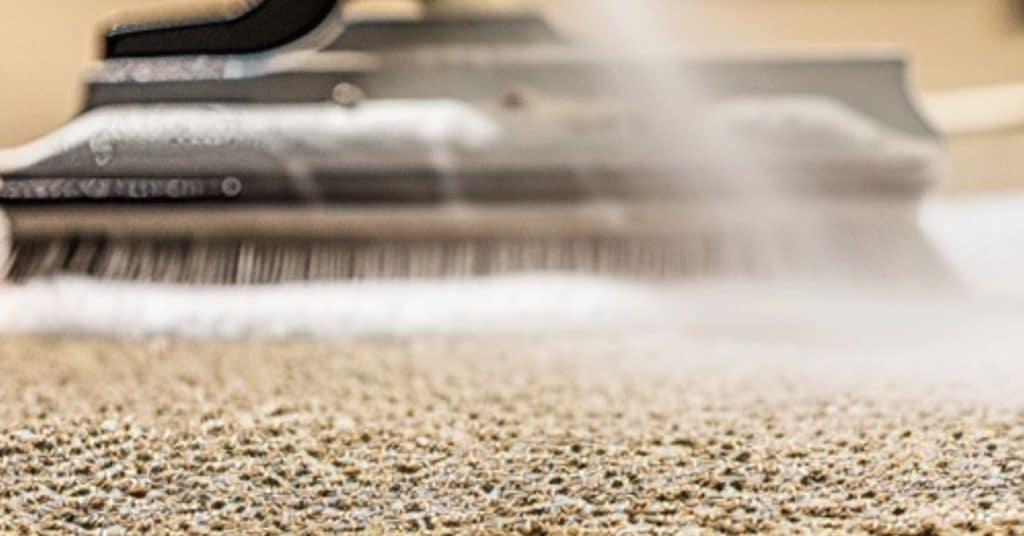In our quest for a cleaner, fresher living space, we often overlook the silent keeper of comfort and style under our feet: our carpets. Over time, they accumulate dust, allergens, and stains, diminishing their beauty and potentially affecting our health. Traditional vacuuming, while helpful, can’t always reach the deep-seated dirt and grime. That’s where steam cleaning steps in as a game-changer.
Steam cleaning, a method praised for its effectiveness and efficiency, delves deep into carpet fibers, extracting dirt and debris that regular cleaning methods can’t. It’s not just about surface cleanliness; it’s about rejuvenating your carpet and, by extension, your home.
As we explore how carpet steam cleaning works, we’ll uncover the science behind the steam and how it can transform your carpets from dull to dazzling.
Understanding Carpet Steam Cleaning (Hot Water Extraction)
What Is Steam Cleaning?
Carpet steam cleaning, often referred to as hot water extraction, involves using high-temperature steam to clean carpets. We introduce water heated to a high temperature into the carpet fibers via a high-pressure jet.
Comparted to other carpet cleaning methods, this method doesn’t just dab at the surface; it penetrates deep, reaching the dirt and grime that regular vacuuming can’t. And here’s a fun fact: despite its name, steam cleaning actually uses more hot water than steam. It’s not about the steam’s visibility but its cleaning power.
The Science of Steam Cleaning Carpets
Let’s dive into how exactly carpet steam cleaning gets the job done. At its core, this process utilizes high temperatures to produce steam, which then loosens up the dirt, stains, and allergens entrenched within carpet fibers. The science behind it is pretty straightforward: hot water triggers a breakdown of the particles, making them easier to remove.
Following this, a powerful vacuum whisks away the loosened debris, leaving carpets not just cleaner, but also more hygienic. This method is highly effective because it attacks dirt at its hiding spots, offering a deep clean that rejuvenates carpets and, by extension, refreshes our living spaces.
The Carpet Steam Cleaning Process

Preparing the Carpet for Steam Cleaning
First things first, we tackle the prep work. Clearing the area of furniture and other items makes the carpet accessible for an in-depth clean.
A thorough vacuum precedes everything, picking up any loose dirt, dust, and particles. This step is crucial, as it allows the steam cleaning to target the more stubborn dirt and stains embedded in the carpet fibers.
The Role of the Steam Cleaner
Onto the main event: the steam cleaner. This machine injects hot water and a cleaning solution deep into the carpet fibers.
The high temperature of the water activates the detergent on the carpet fibers, while a high-pressure jet loosens the dirt, grime, and allergens. The machine then extracts the water, along with the dislodged dirt. This process doesn’t just clean the surface but rejuvenates the carpet’s appearance and extends its lifespan.
After-Care and Drying
After the steam cleaning adventure, drying becomes the next priority. We advise opening windows or using fans to speed up the drying process, which can take anywhere from 6 to 12 hours.
Avoid walking on cleaned carpet or placing furniture on the carpet until it’s completely dry. This not only helps prevent resoiling but also avoids any potential mold or mildew growth, keeping your carpet fresh and clean for longer.
Benefits of Steam Cleaning for Carpets
Deep Cleaning and Sanitization
Steam cleaning goes beyond what the naked eye can see, reaching deep into carpet fibers. This method uses high temperatures to eliminate bacteria, dust mites, and other nasties that standard vacuums can’t touch.
Imagine giving your carpet a spa day; it’s sort of like that, but instead of cucumber slices over the eyes, it’s a blast of steam that gets rid of the unwanted guests.
Allergy Relief and Improved Air Quality
We all love a breath of fresh air, right? Well, steam cleaning carpets has a way of making that happen inside your home. By zapping away allergens such as pet dander, pollen, and dust mites, steam cleaning can significantly reduce allergy symptoms.
It’s like having an invisible force field that keeps the sneezes and sniffles at bay. Plus, by clearing out these microscopic troublemakers, we’re also improving the air quality. Cleaner air means happier lungs and, frankly, happier people.
Extending the Life of Your Carpet
Let’s talk about giving your carpet a longer lease on life. Regular steam cleaning not only keeps it looking fresh but also improves its longevity. Think of it as a routine check-up for your carpet.
Just like us, carpets need a little care to stay in tip-top shape. By removing deep-seated dirt and debris, we’re reducing the wear and tear that can age carpets prematurely. It’s like carpet anti-aging cream, but much more effective and a lot less messy.
Comparing Steam Cleaning to Other Carpet Cleaning Methods
Steam Cleaning vs. Dry Cleaning
When it comes to giving carpets a deep clean, steam cleaning stands out for its ability to penetrate carpet fibers, dissolving dirt and eliminating allergens with high-temperature steam. This method ensures a thorough clean by using water heated to a high temperature that turns into steam, which then gets forced into the carpet and sucked out along with the dislodged dirt. It’s a process that goes beyond surface-level cleaning.
On the flip side, dry cleaning carpets involves the use of specialized machines to apply chemical compounds that bind with dirt, allowing it to be removed without the lengthy drying times associated with steam cleaning.
While dry cleaning is faster, making it convenient for those in a hurry, it may well not reach as deep as steam cleaning. Particularly for those of us with pets or kids, steam cleaning’s ability to deep cleanse could be the deciding factor, despite the longer drying time.
Steam Cleaning vs. Shampooing
Shampooing carpets is another classic approach, where a foamy chemical is spread on the carpet and scrubbed in with a motorized brush. This method aims to agitate and dissolve dirt, which is then vacuumed away.
Sounds great, right? Well, the challenge here lies in the residue. Often, shampooing leaves behind a sticky residue that can attract more dirt over time, not exactly what we want for a “clean” carpet.
Steam cleaning, in contrast, uses its high-temperature steam to strike the perfect balance between effective cleaning and minimal residue, making it a stellar choice for those of us aiming to keep our homes allergen and dirt-free without additional hassle. Plus, it’s just satisfying to know that the heat from the steam helps kill bacteria and dust mites lurking within our carpets, offering not just cleanliness but also peace of mind.
In wrapping up, whether it’s choosing between the speed and convenience of dry cleaning, the thoroughness of steam cleaning, or the traditional approach of shampooing, considering our lifestyle and carpet care needs will guide us to the best method. After all, ensuring our living spaces are clean and healthy is our ultimate goal.
Professional Steam Cleaning vs. DIY
When to Hire a Professional
Opting for professional carpet steam cleaning service becomes crucial when the challenge at hand surpasses our expertise or available resources. Professionals come equipped with industrial-grade machinery that delivers a level of cleanliness unattainable with most household steam cleaners.
If your carpets are heavily soiled, display stubborn stains, or you’re dealing with high-traffic areas that haven’t seen a deep clean in a while, it’s time to call in the experts for steam cleaning services. They understand carpet fibers and their reactions to various treatments, ensuring your carpet gets the care it deserves without the risk of damage.
Plus, if you have done the cleaning yourself before and your carpets still look dirty after steam cleaning, or if you’re looking for convenience or need to guarantee a specific result, such as for end-of-lease conditions, investing in a professional service pays off.
Tips for Effective DIY Steam Cleaning
For those of us keen on tackling carpet steam cleaning ourselves, success lies in the preparation and process. First, thoroughly vacuum the area to remove surface dirt, dust, and pet hair. This step prevents mud from forming when you add water. Then, pretreat stains and high-traffic areas with a suitable cleaning solution to improve the overall effectiveness of your cleaning session. During the steam cleaning, keep a slow and steady pace to allow the steam to penetrate deeply.
Afterward, ensure the room is well-ventilated to speed up drying time, preventing mold and mildew growth. Regularly maintaining your machine, such as emptying the water tank and cleaning the filters, will keep it in top condition, ready for the next use. Embracing these tips can make a significant difference in your DIY steam cleaning efficiency, rivaling professional outcomes with a bit of elbow grease and dedication.
Potential Challenges and Precautions
Understanding Carpet Material and Steam Cleaning Compatibility
Not all carpets take kindly to steam cleaning. Yep, it’s a bit like giving some pets a bath – not all of them will sit still for it. Understanding your carpet’s material is crucial, as some fibers can shrink or get damaged by high temperatures.
Wool, for example, can be quite temperamental under steam cleaning, while nylon tends to be more forgiving. Before letting steam anywhere near your carpet, check the manufacturer’s guidelines or consult a professional. This step saves you from a world of regret and keeps your carpet looking its best.
Dealing With Stubborn Stains and Water Damage
Here’s a tough nut to crack: stubborn stains and water damage. These issues are the bane of many carpet owners’ existence. Pretreating stains with a gentle, appropriate cleaning solution increases your chances of removing them. However, remember, steam cleaning isn’t a magic wand for all stains, especially those that are deeply set or caused by substances like wine or ink.
As for water damage, it’s a tricky beast. Steam cleaning can actually exacerbate the problem if not done correctly. Excessive moisture without proper extraction can lead to mold and mildew. Always exercise caution and consider professional help for severe cases to protect your carpet and your sanity.
See more:

